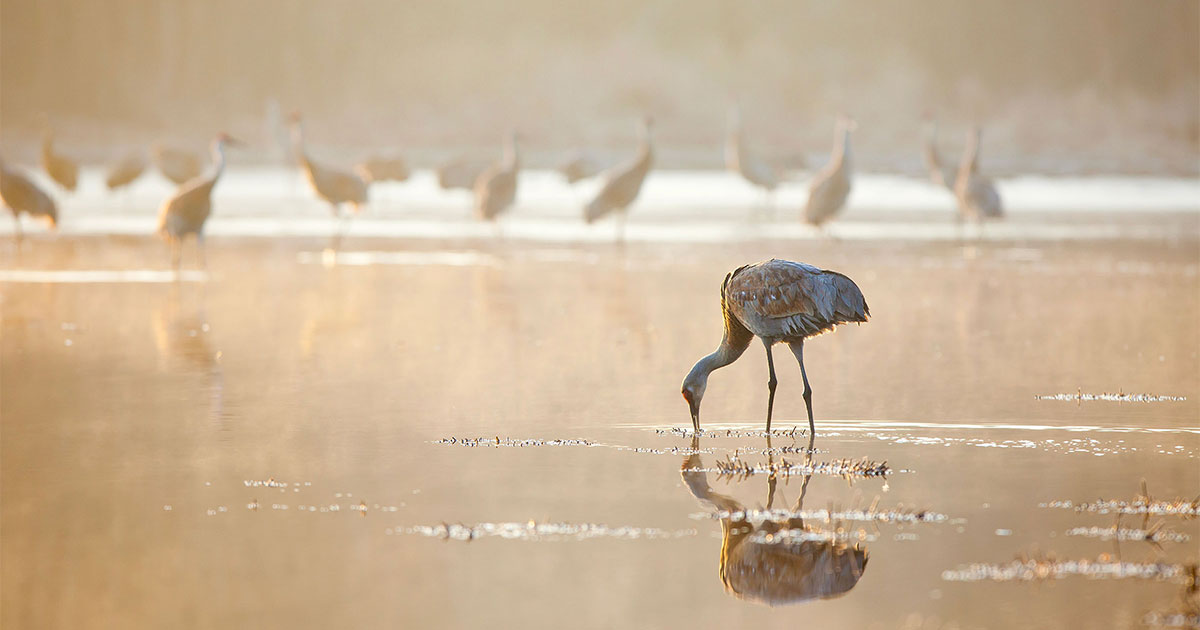Sandhill Cranes are gateway birds: Encountering their impressive size, elegant movements, and prehistoric croaking calls can turn any casual observer into a full-fledged birder. What’s more, their multitudes at migration stopover sites are almost overwhelming in scale, most notably in the spring at Audubon’s Rowe Sanctuary and other sites in Nebraska’s Platte River Valley, where more than half a million cranes congregate.
While spring shines a brighter spotlight on Sandhills, fall is a fantastic time to seek out these beautiful birds. For one, it’s a chance to watch juveniles on their first migration learning the ropes from their parents, which typically mate for life.
Autumn also spreads the spectacle of crane migration more evenly across the country. Nebraska owes its staggering spring profusion to the midcontinent Sandhill Crane population’s habit of making lengthy stops there to rest and refuel. In fall, on the other hand, these birds move briskly from breeding sites found in Canada, Alaska, and Siberia to wintering areas on the Gulf Coast and across the Southwest into Mexico. But others reverse that rhythm: The eastern population, for example, makes a businesslike spring migration but lingers in massive flocks en route from nesting grounds in the Great Lakes region and New England to winter territory in the South. Researchers generally agree that these divergent migration patterns are likely related to the distances traveled or competition for territory at different times of the year. The result is that, come autumn, huge flocks are within reach for birders across much of the country.
Here are four fall stopover sites where these ancient creatures will amaze visitors. (The first three also offer occasional glimpses of the much rarer Whooping Crane.) Witnessing the throngs of Sandhill Cranes that rely on these areas reminds us that respecting and protecting these gathering sites is essential.
Jasper-Pulaski Fish and Wildlife Area, Indiana
About two hours southeast of Chicago, this farm-flanked wetland has hosted Sandhill Cranes for millennia. Today it boasts the largest concentration east of the Mississippi River, with early arrivals in October and numbers peaking in late November or early December. Step onto the site’s viewing platform just before sunset to see up to 30,000 cranes gathering to socialize after feeding all day on unharvested grains and invertebrates. Some cranes now stay through the winter, evidence of their ability to adapt to a warmer climate.
Wheeler National Wildlife Refuge, Alabama
Large flocks at this refuge along the Tennessee River in Decatur, Alabama, demonstrate how cranes have adapted to a human-dominated landscape. Renovations underway include a new blind for photographers and a glass-walled observation room where you can escape from the cold while listening to cranes’ trumpeting vocalizations piped in through speakers. Visit midday from late November into the winter months—like Jasper-Pulaski, Wheeler has transformed from a fall stopover to an overwintering site—to see around 10,000 cranes up close. For a more rural experience on the same river, visit Hiwassee Wildlife Refuge three hours northeast in Tennessee.
Aldo Leopold Shack and Farm, Wisconsin
Leopold, a prominent early 20th century writer and wildlife ecologist, watched with awe and sadness as Sandhill Cranes descended on the Wisconsin River in front of his shack each fall. “Their annual return is the ticking of the geological clock,” he wrote. Leopold worried he’d see the cranes go extinct in his lifetime, but wetland conservation and hunting restrictions enabled them to rebound. Today the Aldo Leopold Foundation offers tours of the shack from May through October and hosts a crane festival on the second weekend of November, in partnership with the International Crane Foundation, that features paid tours to blinds along the river. Between mid-October and Thanksgiving, visitors can expect to see several thousand birds; public lands such as Necedah National Wildlife Refuge offer viewing spots where no ticket is required.
Columbia River Lowlands, Oregon and Washington
Just a half-hour drive north of Portland, Oregon, in the Columbia River lowlands on the Washington border, Sandhills that breed in Alaska stop to rest each fall, midway to wintering territory in California’s Central Valley. Across the river in Washington, spot them from your car while driving through Ridgefield National Wildlife Refuge or at neighboring Crane’s Landing, a conservation area planted with grasses and wheat for them to forage. On the Oregon side, spot Sandhills, eagles, swans, and herons at Sauvie Island Wildlife Area.
This piece originally ran in the Fall 2023 issue as “The Other Sandhill Season.” To receive our print magazine, become a member by making a donation today.

